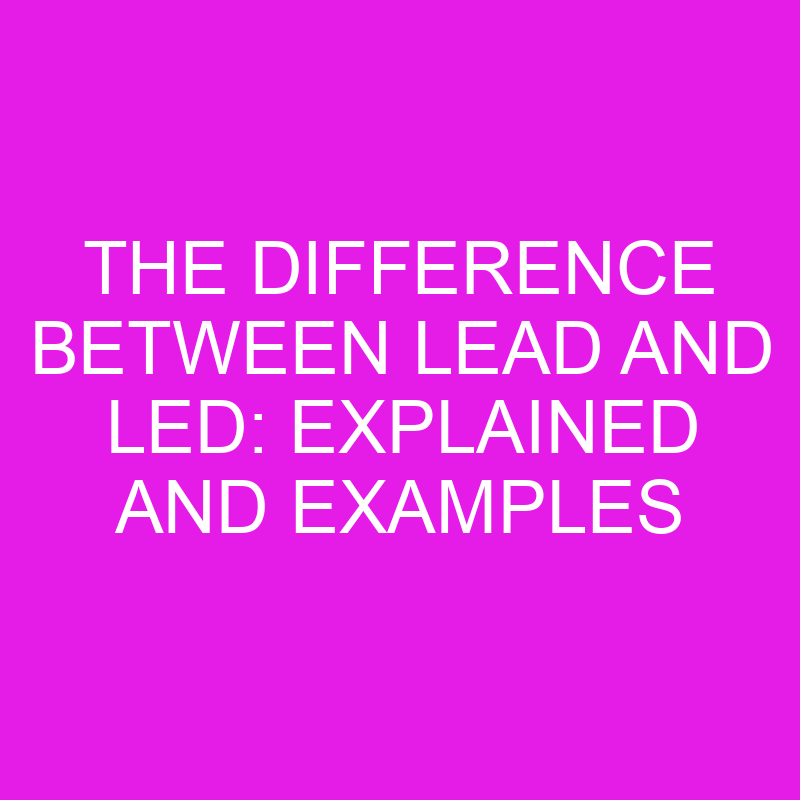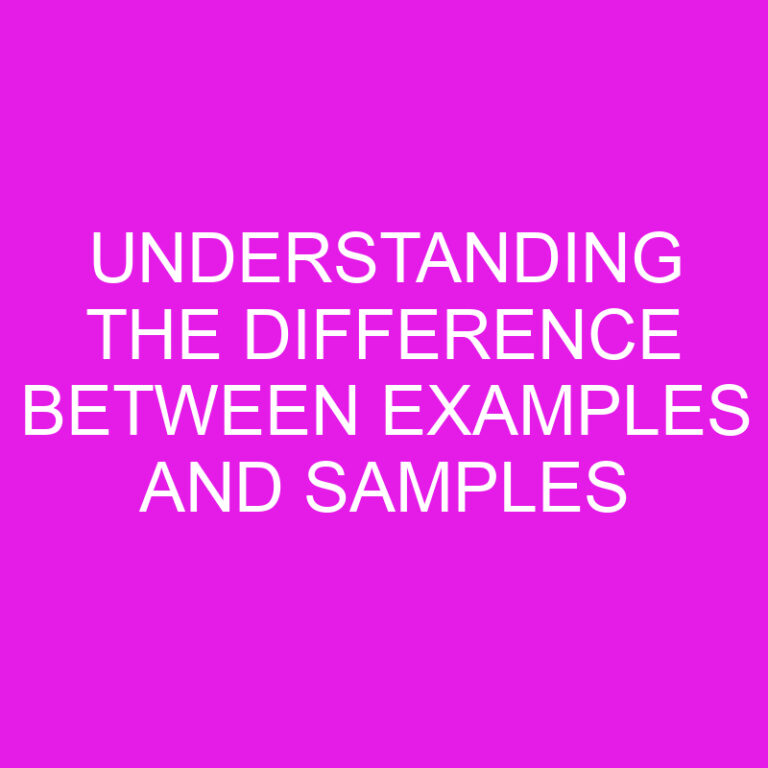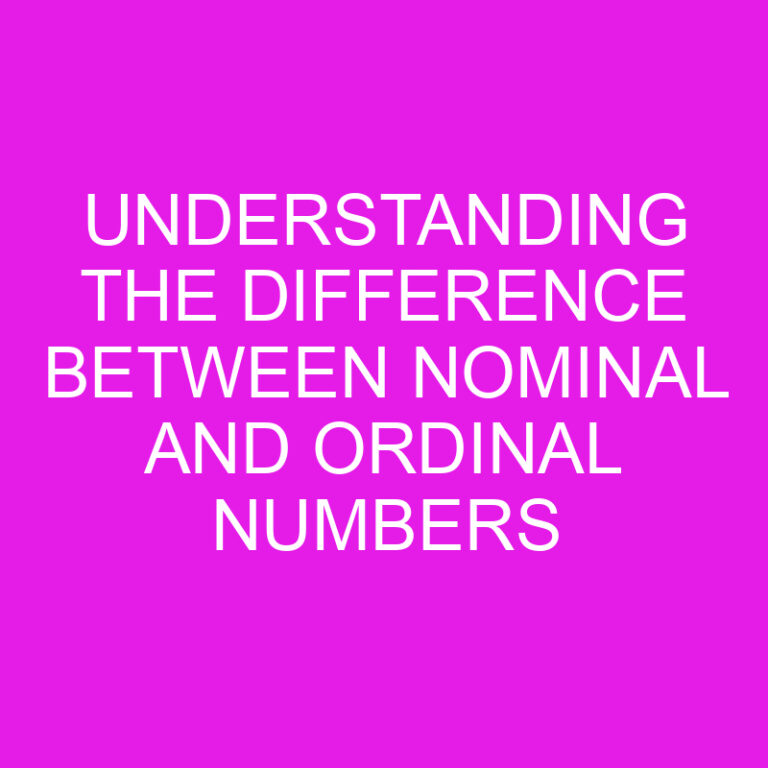
Hey there! Ever get confused between “lead” and “led”? You’re not alone! These two words may sound similar, but they have completely different meanings and uses. In this article, I’ll break down the key differences between “lead” and “led” so that you can use them correctly in your writing.
First things first, let’s talk about “lead.” It’s pronounced “leed” and can be used as both a noun and a verb. As a noun, “lead” refers to a heavy, malleable metal. However, as a verb, “lead” means to guide or direct someone or something. For example, “I will lead the team to victory” or “She is leading the project.”
On the other hand, “led” is the past tense of the verb “lead.” It’s pronounced “led” (rhymes with “red”) and is used when referring to something that has already happened. For instance, “He led the team to victory yesterday” or “The teacher led the class on a field trip last week.”
Now that we’ve cleared up the confusion between “lead” and “led,” you’ll be able to use these words with confidence and precision. So, let’s dive deeper into the differences between them and explore some examples to solidify your understanding.
Post Contents
Key Takeaways
- The word “lead” can be both a noun and a verb, with different meanings and uses.
- As a noun, “lead” refers to a heavy metal, while as a verb, it means to guide or direct someone or something.
- “Led” is the past tense of the verb “lead” and is used when referring to something that has already happened.
- It’s crucial to differentiate between “lead” and “led” to ensure accurate communication.
- “Lead” as a noun refers to a chemical element and has various applications in different industries.
- When “lead” is used as a verb, it can mean to guide or direct, be in charge, or have a position ahead of others in a line or procession.
What is “lead”?
“Lead” is a word that can act as both a noun and a verb, and it often causes confusion due to its multiple meanings. As a noun, “lead” refers to a heavy metal that is known for its toxicity. It is commonly used in manufacturing and construction industries, as well as in batteries and ammunition.
As a verb, “lead” means to guide or direct someone or something. It is often associated with taking charge or showing the way. For example, a team leader may lead their group to success through effective guidance and direction. “Lead” can also be used in the context of leading a discussion, leading a charge, or leading by example.
It’s essential to note that “lead” should not be confused with “led.” “Led” is the past tense of “lead” and is used when referring to something that has already happened. It indicates that someone or something was guided or directed in the past.
To illustrate the difference, let’s look at some examples:
- As a noun: “The paint used in old houses may contain lead, which is harmful if ingested.”
- As a verb: “I will lead the team meeting tomorrow to discuss our new project.”
- In past tense: “He led the team to victory in the championship game.”
Understanding the distinction between “lead” and “led” helps prevent confusion and ensures accurate communication. Whether you’re referring to the metal or describing actions of guiding and directing, using the correct form of the word is vital.
“Lead” as a noun
When used as a noun, “lead” refers to a chemical element. This metallic substance has a bluish-gray color and is dense, soft, and malleable. It belongs to the carbon group on the periodic table and has the atomic number 82.
| Atomic Number | Atomic Symbol | Atomic Weight |
|---|---|---|
| 82 | Pb | 207.2 |
The noun form of “lead” has been used for centuries. In fact, it derives from the Middle English word “led” and mainly refers to the element itself.
“Lead” as a noun has various applications in different industries. It has been widely used in construction, especially for roofing materials. Its corrosion-resistant properties make it an ideal choice for protecting structures from harsh weather conditions.
Additionally, “lead” has been utilized in the manufacturing of batteries, ammunition, and various other products. However, it’s essential to note that prolonged exposure to lead can have detrimental effects on human health, leading to lead poisoning.
Understanding the distinct usage of “lead” as a noun is crucial to prevent miscommunication. By correctly identifying the noun form, we ensure clarity and avoid confusion, especially in technical discussions or when dealing with specific elements in the industrial and scientific realms.
Now that we’ve explored the noun form of “lead,” let’s delve into its usage as a verb and explore its different meanings and contexts.
“Lead” as a verb
When it comes to the word “lead” as a verb, it carries a completely different meaning compared to its noun form. As I mentioned earlier, “lead” as a noun refers to a heavy metal, but as a verb, it has a distinct role in the English language. Let’s explore its usage and meaning further.
- To guide or direct: One of the primary meanings of “lead” as a verb is to guide or direct someone or something. For example:
- I’ll lead the team to victory.
- She led the discussion with confidence.
- The tour guide led us through the historic city streets.
- To be in charge: Another important usage of “lead” as a verb is to indicate that someone is in charge or has authority over a group or organization. Consider the following examples:
- He leads the company as the CEO.
- They elected her to lead the committee.
- The captain leads the football team during matches.
- To have a position in front: Additionally, “lead” can also mean to have a position ahead of others in a line or procession. This usage is often encountered in specific contexts, such as marching bands or parades. Here are some examples:
- The drum major leads the marching band.
- The groom led the wedding procession.
It’s crucial to recognize the various meanings and contexts in which “lead” can be used as a verb. This understanding will help you accurately communicate your intentions and ensure effective communication with others. Now that we’ve covered the verb form of “lead,” let’s move on to explore the word “led” in the next section.
What is “led”?
Now that we have explored the different meanings and usages of the verb “lead,” let’s turn our attention to its past tense form, “led.”
While “lead” is used when referring to the present or future actions of guiding or directing someone or something, the word “led” is specifically used when discussing past actions.
By changing the “ea” in “lead” to “e,” we create the past tense form of the verb. For example, if I say “I led the team to victory,” I am referring to a specific action in the past where I took charge and guided the team towards success.
It is important to note that “led” is pronounced differently from “lead.” Unlike the two different ways we pronounce “lead” depending on its meaning (leed or led), the word “led” is pronounced as “led” with a short “e” sound.
Here are a few examples of sentences using the word “led” in different contexts:
- The CEO led the company through a period of growth and expansion.
- The teacher led the students on an educational field trip.
- The conductor led the orchestra in a mesmerizing performance.
Understanding the subtle difference between “lead” and “led” is crucial for effective communication, as it ensures that we accurately convey the timeframe of the actions we are referring to. Whether it’s discussing present, future, or past actions, choosing the correct form of the verb “lead” allows us to communicate our thoughts clearly and avoid any confusion.
Now that we have covered the concept of “led,” let’s explore some common mistakes people make when using these words and how to avoid them.
“Led” as the past tense of “lead”
When it comes to using the past tense of “lead,” it’s important to remember that the correct form is “led.” I often see people using “lead” as the past tense, but this is a common mistake that can confuse readers and listeners.
Using “led” correctly in your writing or conversation helps convey a clear understanding of when an action has taken place in the past. It’s a small but significant distinction that can greatly enhance the effectiveness of your communication.
Here are a few examples to illustrate the correct usage of “led”:
- “I led the team to victory in last week’s game.” (past tense)
- “She led the project to its successful completion.” (past tense)
- “He led the company through challenging times.” (past tense)
By using “led,” you indicate that the action took place at a specific time in the past. This clarity allows your reader or listener to understand the timeline of events accurately.
So, the next time you want to express a past action related to leading or directing, remember to use “led” as the correct past tense form of “lead.” This simple adjustment can make a world of difference in your written and spoken communication. Let’s move on to the next section, where we’ll explore some common mistakes people make when using “lead” and “led” and how to avoid them.
Examples of using “lead” and “led”
While the words “lead” and “led” may seem similar, it’s important to understand how and when to use them correctly. Let’s look at some examples to further illustrate their usage:
- Using “lead”
- I lead my team to victory in the championship game.
- She has the ability to lead with empathy and compassion.
- The teacher will lead the class in a discussion about the topic.
Here, “lead” is used as a verb, indicating the action of guiding or directing someone or something. It can also imply being in charge or having authority over a group or organization.
- Using “led”
- He led the expedition to the top of the mountain.
- The CEO led the company through a successful rebranding process.
- They led the protest against unfair working conditions.
In these examples, “led” is the past tense form of “lead” and is used to denote an action that has already happened in the past. It indicates that someone or something was in a position of leadership or guiding others at a specific point in time.
Understanding when to use “lead” and “led” correctly ensures effective communication and prevents confusion. Remember, “lead” is used for present or future actions, while “led” is used for past actions.
I’ll now move on to the next section, which will cover common mistakes people make when using these words and how to avoid them.
Conclusion
Understanding the difference between “lead” and “led” is crucial for effective communication. As we have discussed, “lead” is used as a verb to indicate guiding or directing someone or something, having authority or being in charge, and being ahead of others in a line or procession. On the other hand, “led” is the past tense form of “lead” and is used to denote an action that has already happened in the past.
By using “lead” and “led” correctly, we can avoid confusion and ensure that our message is clear. Whether we are leading a team, leading a project, or simply describing past events, using the correct form of these words is essential.
In the next section, we will explore common mistakes that people make when using “lead” and “led” and provide tips on how to avoid them. By understanding these common pitfalls, we can further enhance our communication skills and convey our thoughts accurately.
Remember, mastering the usage of “lead” and “led” will not only improve your writing but also showcase your command over the English language. So keep practicing and soon you’ll be leading the way with your impeccable grammar.
Frequently Asked Questions
Q: What is the article about?
A: The article discusses the correct usage of the words “lead” and “led” and provides examples to illustrate their usage.
Q: How is “lead” used?
A: “Lead” is used as a verb to indicate guiding or directing someone or something, having authority over a group or organization, or being ahead of others in a line or procession.
Q: What is “led”?
A: “Led” is the past tense form of “lead” and is used to denote an action that has already happened in the past.
Q: Why is it important to use “lead” and “led” correctly?
A: Using “lead” and “led” correctly ensures effective communication and prevents confusion.
Q: What will the next section of the article cover?
A: The next section will cover common mistakes people make when using “lead” and “led” and how to avoid them.






